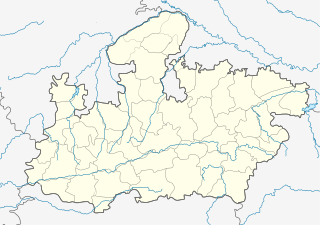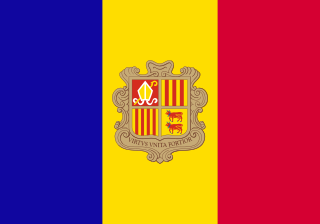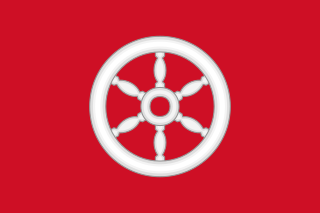Sovereign states
A
- Ahom - Ahom Kingdom







- Anziku – Anziku Kingdom





Alirajpur is a town and a municipality in Alirajpur district in the state of Madhya Pradesh, India.

Andorra, officially the Principality of Andorra, also called the Principality of the Valleys of Andorra, is a sovereign landlocked microstate on the Iberian Peninsula, in the eastern Pyrenees, bordering France to the north and Spain to the south. Believed to have been created by Charlemagne, Andorra was ruled by the Count of Urgell until 988, when it was transferred to the Roman Catholic Diocese of Urgell, and the present principality was formed by a charter in 1278. It is known as a principality as it is a diarchy headed by two Princes: the Catholic Bishop of Urgell in Catalonia, Spain, and the President of France.

Anhalt-Bernburg was a principality of the Holy Roman Empire and a duchy of the German Confederation ruled by the House of Ascania with its residence at Bernburg in present-day Saxony-Anhalt. It emerged as a subdivision from the Principality of Anhalt from 1252 until 1468, when it fell to the Ascanian principality of Anhalt-Dessau. Recreated in 1603, Anhalt-Bernburg finally merged into the re-unified Duchy of Anhalt upon the extinction of the line in 1863.
B
- Baden – Grand Duchy of Baden
- Baguirmi – Kingdom of Baguirmi
- Bambara – Bambara Empire
- Baol – Kingdom of Baol


- Bhutan – Kingdom of Bhutan
- Bornu – Bornu Empire





- Burundi – Kingdom of Burundi

The Grand Duchy of Baden was a state in the southwest German Empire on the east bank of the Rhine. It existed between 1806 and 1918.

The Bamana Empire was a large West African state based at Ségou, now in Mali. This state was established after the fall of the Mali Empire and the Keita dynasty, as a smaller Bambara Empire founded by other Bambara families related to the Keita clan. It was ruled by the Kulubali or Coulibaly dynasty established c. 1640 by Kaladian Coulibaly also known as Fa Sine or Biton-si-u. The empire existed as a centralized state from 1712 to the 1862 invasion of Toucouleur conqueror El Hadj Umar Tall.
The Kingdom of Baol or Bawol in central Senegal was one of the kingdoms that arose from the split-up of the Empire of Jolof (Diolof) in 1555. The ruler reigned from a capital in Diourbel.
C
- Cambodia – Kingdom of Cambodia
- Cayor – Kingdom of Cayor
- China – Great Qing Empire


The Dark ages of Cambodia, also called the Middle Period, refers to the historical era from the early 15th century to 1863, the beginning of the French Protectorate of Cambodia. As reliable sources are very rare, a defensible and conclusive explanation that relates to concrete events that manifest the decline of the Khmer Empire, recognised unanimously by the scientific community, has so far not been produced. However, most modern historians have approached a consensus in which several distinct and gradual changes of religious, dynastic, administrative and military nature, environmental problems and ecological imbalance coincided with shifts of power in Indochina and must all be taken into account to make an interpretation. In recent years scholars' focus has shifted increasingly towards human–environment interactions and the ecological consequences, including natural disasters, such as flooding and droughts.

Cayor was the largest and most powerful kingdom (1549–1879) that split off from the Jolof Empire in what is now Senegal. Cayor was located in northern and central Senegal, southeast of Walo, west of the kingdom of Jolof, and north of Baol and the Kingdom of Sine.

Cospaia is an Italian hamlet (frazione) of the comune of San Giustino in the Province of Perugia, Umbria.
D
- Dahomey – Kingdom of Dahomey



The Kingdom of Dahomey was an African kingdom that existed from about 1600 until 1894, when the last king, Béhanzin, was defeated by the French, and the country was annexed into the French colonial empire. Dahomey developed on the Abomey Plateau amongst the Fon people in the early 17th century and became a regional power in the 18th century by conquering key cities on the Atlantic coast.

Denmark, officially the Kingdom of Denmark, is a Nordic country and the southernmost of the Scandinavian nations. Denmark lies southwest of Sweden and south of Norway, and is bordered to the south by Germany. The Kingdom of Denmark also comprises two autonomous constituent countries in the North Atlantic Ocean: the Faroe Islands and Greenland. Denmark proper consists of a peninsula, Jutland, and an archipelago of 443 named islands, with the largest being Zealand, Funen and the North Jutlandic Island. The islands are characterised by flat, arable land and sandy coasts, low elevation and a temperate climate. Denmark has a total area of 42,924 km2 (16,573 sq mi), land area of 42,394 km2 (16,368 sq mi), and the total area including Greenland and the Faroe Islands is 2,210,579 km2 (853,509 sq mi), and a population of 5.8 million.

Norway, officially the Kingdom of Norway, is a Nordic country in Northern Europe whose territory comprises the western and northernmost portion of the Scandinavian Peninsula; the remote island of Jan Mayen and the archipelago of Svalbard are also part of the Kingdom of Norway. The Antarctic Peter I Island and the sub-Antarctic Bouvet Island are dependent territories and thus not considered part of the kingdom. Norway also lays claim to a section of Antarctica known as Queen Maud Land.
E

F
- Fiji – Tui Viti

- Frankfurt – Grand Duchy of Frankfurt
- Futa Jallon – Imamate of Futa Jallon
- Futa Toro – Imamate of Futa Toro

Fiji, officially the Republic of Fiji, is an island country in Melanesia, part of Oceania in the South Pacific Ocean about 1,100 nautical miles northeast of New Zealand's North Island. Its closest neighbours are Vanuatu to the west, New Caledonia to the southwest, New Zealand's Kermadec Islands to the southeast, Tonga to the east, the Samoas and France's Wallis and Futuna to the northeast, and Tuvalu to the north. Fiji consists of an archipelago of more than 330 islands—of which 110 are permanently inhabited—and more than 500 islets, amounting to a total land area of about 18,300 square kilometres (7,100 sq mi). The most outlying island is Ono-i-Lau. The two major islands, Viti Levu and Vanua Levu, account for 87% of the total population of 898,760. The capital, Suva, on Viti Levu, serves as the country's principal cruise-ship port. About three-quarters of Fijians live on Viti Levu's coasts, either in Suva or in smaller urban centres such as Nadi—where tourism is the major local industry—or Lautoka, where the sugar-cane industry is paramount. Due to its terrain, the interior of Viti Levu is sparsely inhabited.

The First French Empire, officially the French Empire, was the empire of Napoleon Bonaparte of France and the dominant power in much of continental Europe at the beginning of the 19th century. Although France had already established an overseas colonial empire beginning in the 17th century, the French state had remained a kingdom under the Bourbons and a republic after the Revolution. Historians refer to Napoleon's regime as the First Empire to distinguish it from the restorationist Second Empire (1852–1870) ruled by his nephew as Napoleon III.

The Grand Duchy of Frankfurt was a German satellite state of Napoleonic creation. It came into existence in 1810 through the combination of the former territories of the Archbishopric of Mainz along with the Free City of Frankfurt itself.
G
The Kingdom of Garo, also known as Bosha after its ruling dynasty, was an ancient kingdom in the Horn of Africa. Established by the mecha oromo, it was situated on the periphery of the Gibe region. The garo oromo was named from the word (gaara) means "the upper site", the place where they were living at that time.

The Kingdom of Gomma was one of the kingdoms in the Gibe region of Ethiopia that emerged in the 18th century. It was based in Agaro.

The Kingdom of Gumma was one of the kingdoms in the Gibe region of Ethiopia that emerged in the 18th century. Its eastern border was formed by the bend of the Didessa River, which separated it from Limmu-Ennarea to the northeast, and the kingdoms of Gomma and Gera to the south. Beyond its northern border were various Macha Oromo groups, and to the west Sidamo groups. Its territory corresponds approximately with the modern woredas of Gechi and Didessa.
H






J
K
- Kaabu – Kingdom of Kaabu
- Kaffa – Kingdom of Kaffa
- Kénédougou – Kénédougou Kingdom
- Khasso – Kingdom of Khasso

- Kokand – Khanate of Kokand
- Kong – Kong Empire


- Koya Temne – Kingdom of Koya
L

- Limmu-Ennarea – Kingdom of Limmu-Ennarea

- Loango – Kingdom of Loango
- Luba – Luba Empire
- Lunda – Lunda Empire
M
N



O

- Ouaddai – Ouaddai Empire
- Oyo – Oyo Empire
P
R
- Rapa Nui – Kingdom of Rapa Nui

- Rwanda – Kingdom of Rwanda

S
- Samoa – Kingdom of Samoa

- Sardinia – Kingdom of Sardinia




- Sikkim – Chogyalate of Sikkim



T
- Tahiti – Kingdom of Tahiti
- Tonga – Tu'i Tonga

U


W
- Welayta – Kingdom of Welayta

